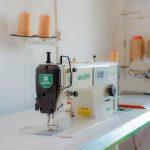You've spent hours meticulously stitching your project, and now it's time to close it with finesse. Perfecting the art of closing a stitch is essential for achieving a professional, polished look in your sewing endeavors.
In this guide, you will discover five expert techniques to flawlessly finish your stitches, ensuring that every project exudes a sense of mastery and precision.
From backstitching for a secure closure to invisible stitching for seamless results, each method is designed to elevate your sewing skills to the next level.
Whether you're creating garments, quilts, or crafts, mastering these techniques will add a touch of sophistication to your work, setting you apart as a skilled sewing artisan.
Key Takeaways
- Backstitching for secure closure
- Knotting techniques for a neat finish
- Seam finishing methods for durability and a professional appearance
- Invisible stitching techniques for creating invisible stitches
Backstitching for Secure Closure
When you reach the end of your seam, backstitch to secure the closure. Backstitching is a crucial technique in sewing that reinforces the end of a seam, preventing it from unraveling. To execute a secure backstitch, set your machine to a medium stitch length and sew in reverse for a few stitches. Then, switch to forward stitching and continue sewing to the end of the seam. Once you reach the end, switch back to reverse stitching for a few stitches before finishing off. This creates a strong, secure closure that will withstand wear and tear.
In addition to backstitching, it's important to pay attention to thread tension. Proper thread tension ensures that the stitches are balanced and even. Adjust the tension settings on your sewing machine to achieve the ideal balance, preventing loose or tight stitches.
Mastering backstitching and understanding thread tension are essential skills for achieving professional, durable seams. By incorporating these techniques into your sewing practice, you can ensure that your closures are secure and long-lasting. Remember, attention to detail and precision are key in achieving mastery in sewing.
Knotting Techniques for Neat Finish
To achieve a neat finish, secure your stitching by using a knotting technique that prevents unraveling. Proper knotting techniques are essential for ensuring that your hard work in stitching remains intact. Here are some essential knotting techniques and their benefits:
| Knotting Technique | Description | Benefits |
|---|---|---|
| Loop Method | Create a loop before pulling the thread | Prevents slipping and holds the stitch in place |
| Lock Stitch | Secure by sewing through a previous stitch | Ensures the thread doesn't loosen or unravel |
| Backstitch Knot | Sew back into the stitches to form a knot | Provides a strong and secure finish |
| Quilter's Knot | Looping the thread to form a knot | Ideal for quilting and securing layers |
| French Knot | Wrap the thread around the needle | Adds decorative embellishments to the stitch |
When employing these knotting techniques, consider aspects such as needle threading and tension control to achieve a perfectly finished stitch. Mastering these knotting techniques will elevate the quality and durability of your stitching, ensuring a professional and polished outcome.
Seam Finishing Methods for Professional Look
Achieve a professional look in your stitching by employing effective seam finishing methods. One method to consider is serger finishing, which uses a serger machine to neatly trim the seam allowance while encasing the raw edge with thread, preventing fraying and providing a clean, professional finish. This method is especially useful for knit fabrics and is favored in mass garment production for its speed and efficiency.
Another technique to elevate the appearance of your seams is bias binding. This involves using bias tape to encase the raw edges of the seam allowance, resulting in a clean and durable finish. Bias binding is versatile and can add a decorative touch to your project, especially when contrasting or coordinating colors are used.
Invisible Stitching for Seamless Results
For achieving seamless results in your stitching, consider mastering the technique of invisible stitching to elevate the professional finish of your seams. Invisible stitching, also known as blind hemming or slip stitching, is a crucial skill for achieving a flawless and polished look in your sewing projects.
Here are four essential tips to help you master invisible stitching:
- Precision is Key: Take your time to ensure that your stitches are as invisible as possible. Carefully align the edges of the fabric and use a needle and thread that match the fabric color to create seamless blending.
- Practice Makes Perfect: Like any skill, mastering invisible stitching requires practice. Start with scrap fabric to perfect your technique before working on your actual project.
- Maintain Consistent Tension: Keep your stitches and tension consistent throughout the seam to ensure an even and seamless finish.
- Finishing Touch: Once you've completed the invisible stitching, press the seam to set the stitches and create a smooth, professional finish.
Topstitching Tips for Polished Edges
Mastering topstitching techniques elevates the professional finish of your sewing projects, ensuring polished edges and added durability to your seams.
When aiming for polished edges, the choice of presser foot plays a crucial role. Opt for a presser foot with a guide to help you maintain a consistent distance from the edge. As you sew, keep the fabric aligned with the guide to achieve even topstitching.
Additionally, consider adjusting the thread tension to enhance the quality of your topstitching. Experiment with different thread tension settings on scrap fabric to find the ideal balance. Proper thread tension prevents loose or tight stitches, contributing to a refined topstitching appearance.
Remember to test your topstitching on a fabric scrap before sewing on your actual project. By mastering presser foot techniques and thread tension adjustments, you can elevate the quality of your topstitching, resulting in impeccably polished edges that add a professional touch to your sewing projects.
Frequently Asked Questions
Can You Recommend Any Specific Thread Brands or Types That Work Best for Closing Stitches?
You should consider using high-quality thread brands like Gutermann or Coats & Clark for closing stitches. Ensure proper thread tension and use stitching tools like seam rippers for precision. Select appropriate needle types and consider seam finishing techniques for optimal results.
Are There Any Alternative Techniques for Closing Stitches if I Don't Have a Sewing Machine?
If you don't have a sewing machine, there are various hand sewing techniques you can utilize to close stitches. You can also explore needle alternatives such as curved or leather needles for different materials and projects.
What Should I Do if My Fabric Is Too Thick or Difficult to Backstitch Through?
If your fabric is too thick for backstitching, consider using a running stitch or a slip stitch as alternatives for closing the stitches by hand. Experiment with different needle sizes and thread types for better results.
Is There a Way to Close Stitches Without Leaving a Noticeable Knot on the Fabric?
To achieve an invisible finish when hand sewing, consider using needlework techniques for a seamless closure. By incorporating these methods, you can perfect the art of closing stitches without leaving a noticeable knot on the fabric.
How Can I Prevent My Stitches From Puckering or Pulling When Closing a Seam?
To prevent puckering and achieve smooth seams, ensure proper tension on your machine, use the correct needle and thread, and press seams open or to the side. Pinning fabric properly and sewing slowly can also help.
- Choosing the Right Fabrics for Babies - July 20, 2024
- Impact of Fabrics on Skin Health - July 20, 2024
- Benefits of Antimicrobial Fabrics - July 20, 2024







